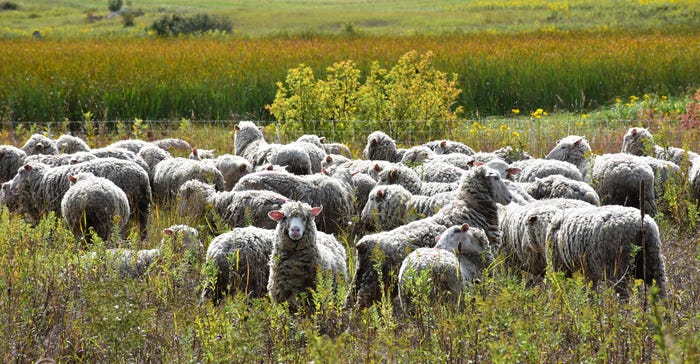April 12, 2022

Foraging sheep, prairie plants and soil health all benefited from a two-month experiment that allowed Chris Schmidt of Minnesota to rotationally graze on neighboring land enrolled in the federal Conservation Reserve Program.
The 45-acre prairie restoration was overdue for mid-contract maintenance, but COVID-19 restrictions made a prescribed burn impossible. Landowners Jim Sehl and Wendy Krueger were looking for another option. Schmidt, who farms near Garvin, Minn., was looking for more pasture. He already had portable water and solar fencing systems.
“The sheep would mimic bison, which would graze on these grasses if the prairies weren’t burned by the fires, pre-white settlement,” Sehl says.
It would take a federal rule change to make the one-time pilot project an accepted practice. If federal and state rules allowed, such a change could potentially open more than 2,000 acres of idled land within 4 miles of Schmidt’s Murray County farm to grazing.
Schmidt farms about 200 acres. He also raises hogs and about 250 breeding ewes. A vocal no-till and cover crop proponent, Schmidt is vice chairman of the Minnesota Soil Health Coalition.
Site-specific plan
Allisa Wendland, a Slayton, Minn.-based Natural Resources Conservation Service soil conservation technician, worked with Schmidt to develop a site-specific rotational grazing plan two years ago. Megan Howell, a Pheasants Forever farm bill biologist, recorded plants and plant parts consumed and planned to compare grazed paddocks with an ungrazed control plot.
“CRP [Conservation Reserve Program] needs to be here to protect against soil erosion. It provides water quality by being an infiltrator and a filtration system, and it provides wildlife habitat,” Wendland says. “For a livestock producer, their goals are obviously to feed their animals, keep them healthy and get them to market. Here, it was a balance to how can we do both aspects.”
Left to reseed every year, grasses eventually would build up a mass of dead plant matter that smothers new growth.
“The regeneration this year [summer 2021] was tenfold,” Schmidt says.
“Songbirds. Butterflies. Bees. All that stuff is intertwined one way or another. We can’t have one without the other. Increase that diversity — not only in plants, but wildlife,” Schmidt says of grazing the landscape. “Our soils are going to benefit from that, which means we can infiltrate more water, which reduces runoff, soil erosion, wind erosion. We’re recycling those nutrients. … Now you have microbiology working like it should, and it’s taking that decayed grass and breaking it down and turning it into nutrients like it should.”
Sheep diversify diet
The project succeeded in terms of grazing, too.
“As far as the animals, it worked out great. They were getting, I’d say, a diversified forage mix and a lot of stuff that they have never seen before,” Schmidt says of the time after the 60 days of grazing. “It was interesting to see what they ate.”
Unexpected, too. Instead of heading straight for the grasses — as they had on other pastures — the sheep avoided the bluestem and ate more forbs.
Big bluestem that had become woody by Aug. 20, when grazing began, was left untouched. The sheep trampled around it to find more tender species, including big bluestem, little bluestem, side-oats grama, wild bergamot, yarrow, purple prairie clover and a couple of the more tender sunflower species.
Land opens up for diverse smaller animals, plants
“The trampled grass is giving it a matting of protection. It acts as first level of protection against the raindrops, and that will help protect against the soil erosion, but it will allow the water to infiltrate because it isn’t a solid mat. Plus, it acts a little bit like a blanket or a shade cover,” Wendland says.
Hoof action benefits wildlife such as pheasants, waterfowl, songbirds and pollinators.
“They’re opening up little spots in the ground to allow forbs and grasses to come up that may have been choked out due to how thick their stand is,” Howell says. “It’s important from a wildlife standpoint in many ways. Beyond creating different successional habitats, it’s also going to be creating a higher diversity level within the stand overall, which is important to all sorts of pollinators and wildlife.”
While Schmidt and his father, Dale, rotated the paddocks more often post-freeze, Schmidt says the animals stayed in good body condition. He doesn’t feed supplements while the animals are on pasture.
The sheep pawed through snow to forage on new-growth cool-season grasses.
“Cool-season grasses can take over our prairies here in Minnesota if they are not kept in check, so having animals out there depleting the cool-season grasses’ carbohydrate storage before winter can help the native species rebound the next growing season,” Howell says.
The following year, Howell saw more side-oats grama, yarrow, sunflower species and fleabane.
The Schmidts started with 50 animals, and later added 25 more. Paddocks, which averaged about 0.75 acre, were grazed for one to five days, depending upon their size, how much forage they contained and how fast the sheep ate.
“It’s the closest we can get to replicating what she [Mother Nature] did before, and then obviously it’s a win for the wildlife because they have a stronger, more diverse stand with less competition as far as invasive species and cool-season grasses like brome,” Howell says. “That’ll be better habitat for brood-rearing pheasants, for nesting habitat. The more diversity we can get on the landscape, the better for ground-nesting birds, grassland birds.”
Wessel is an information officer with the Minnesota Board of Water and Soil Resources.
Source: Minnesota Board of Water and Soil Resources, which is solely responsible for the information provided and is wholly owned by the source. Informa Business Media and all of its subsidiaries are not responsible for any of the content contained in this information asset.
You May Also Like




